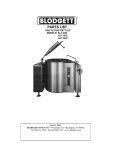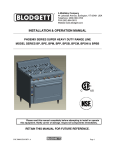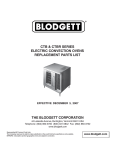Download KTT-20E - Blodgett Oven
Transcript
KTT-20E ELECTRIC FLOOR MODEL TILTING KETTLE INSTALLATION – OPERATION – MAINTENANCE BLODGETT OVEN COMPANY www.blodgett.com 44 Lakeside Avenue, Burlington, Vermont 05401 USA Telephone: (802) 658-6600 Fax: (802) 864-0183 S00049 Rev1D (12/14) IMPORTANT NOTES FOR INSTALLATION AND OPERATION It is recommended that this manual be read thoroughly and that all instructions be followed carefully. This is the safety alert symbol. It is used to alert you to potential personal injury hazards. Obey all safety messages that follow this symbol to avoid possible injury or death. WARNING: Improper installation, operation, adjustment, alteration, service or maintenance can cause property damage, injury or death. Read the installation, operating and maintenance instructions thoroughly before installing, operating or servicing this equipment. Intended for commercial use only. Not for household use. NOTICE: Contact the factory, the factory representative or local service company to perform maintenance and repairs 2 TABLE OF CONTENTS DESCRIPTION PAGE IMPORTANT NOTES FOR INSTALLATION AND OPERATION ................................. 2 SERVICE CONNECTIONS ......................................................................................... 4 1.0 INSTALLATION INSTRUCTIONS ........................................................................ 5 2.0 INTRODUCTION .................................................................................................. 6 3.0 OPERATION INSTRUCTIONS ............................................................................. 7 4.0 CLEANING INSTRUCTIONS ............................................................................... 9 5.0 ADDING WATER ................................................................................................. 11 6.0 VENTING INSTRUCTIONS ................................................................................ 12 7.0 TILTING INSTRUCTIONS .................................................................................. 12 3 SERVICE CONNECTIONS SERVICE CONNECTIONS Electrical connection to be as specified on data plat. COLD WATER: 3/8” O.D. tubing to faucet. (OPTIONAL) HOT WATER: 3/8” O.D. tubing to faucet. (OPTIONAL) ELECTRICAL CHARACTERISTICS 20 gallons 76 litres kW Phase (TOTAL) 12 NOMINAL AMPS PER LINE 208V 220V 240V 380V 415V 480V 600V 1 57.6 54.5 50.0 N/A N/A N/A N/A 3 33.4 31.5 28.9 18.3 16.7 14.5 11.5 SAFETY RELIEF VALVE DIMENSIONS ARE IN INCHES [MM] 4.12 [105] 225 lbs. [102 kg] 1.63 [41] 5.50 [140] 24.25 [616] SHIPPING WT. MIN. CLEARANCE 0 R.H. SIDE 3 [76] L.H. SIDE 7.25 [184] BACK FLANGED FOOT DETAIL 4 EQUALLY SPACED Ø7/16" [11mm] HOLES ON 3 [76] B.C. 31 [787] OPTIONAL FAUCET 6 [152] 20.88 [530] 53.62 [1362] Ø21 [533] 18 [457] KTT-20E CAPACITY 30.62 [778] MODEL 20.5 [521] 24 [610] 15 [381] 8.88 [225] 12.5 [318] 51 [1295] 4 10 [254] 1.0 INSTALLATION INSTRUCTIONS The appliance must be installed in accordance with: 1. State and/or local codes. 2. In the USA, the National Electrical Code, ANSI/NFPA-70 (Latest Edition). In Canada, the Canadian Electrical Code, Part 1, CSA standard C22.1 (Latest Edition) INSTALLATION 1. Select a location to provide drainage directly below the pour path. Allow sufficient rear clearance from wall for kettle to tilt freely and completely without obstruction. 2. Mark hole locations through flanged adjustable feet. Remove feet. 3. On hole locations marked, drill holes and insert expansion shields to accommodate 5/16" size lag bolts. 4. Reposition kettle. Level kettle by making necessary adjustments on flanged feet. 5. Bolt down kettle and seal with Silastic or other equivalent sealing compound. Sealant must be applied not only to bolt heads but also around flanges making contact with floor surface to fulfill NSF International requirements. Wipe off excess sealant immediately. 6. A control box with power supply equivalent to electrical rating of kettle should be located conveniently nearby. 7. A waterproof electrical connection from power supply to rear of control housing must be provided. 8. Ground kettle to terminal provided inside control housing. 9. Turn power ON and check for proper operation. 5 2.0 INTRODUCTION DESCRIPTION Models KTT-20E (20 gallon capacity) is electrically powered, self-contained, tilting kettles. Each model has a jacket of double-wall construction forming a sealed reservoir around the lower twothirds of the kettle. The reservoir is charged with distilled water. Kettles are equipped with a “clean lock” to hold kettle in cooking position or 105 degrees for ease of cleaning, removable electric heating element and controls, including a low water cutoff device for protection of the heating element. All models are of identical construction, except for kettle size and element heating capacity. BASIC FUNCTIONING Self-contained kettles operate by generating steam in the kettle reservoir. The sequence of operation is as follows: 1. Operator turns the power switch to the ON position and sets the temperature control dial at the desired setting from 1 to 10 (90°F to 285°F, 32°C to 140°C, jacket temperature). 2. Control circuit is normally completed to the temperature control if the following conditions exist: a. Water level in the kettle reservoir is adequate to prevent circuit interruption by the low water cut off device. An activated cutoff is indicated by the amber low water light. b. Kettle is in vertical position with circuit completed through the tilt interlock switch. 3. Thermostatic control contacts close to energize contactor coils. 4. Power is supplied to the elements through closed power contactors. 5. As the temperature of water rises in the kettle reservoir, increase in steam pressure is indicated on the pressure gauge. When the temperature of steam in the reservoir reaches the setting shown on the temperature control dial, the temperature controller opens to break the contacts and shut off the heating element. On/off cycles will occur as required to maintain temperature control. 6 3.0 OPERATION INSTRUCTIONS 1. Ensure that the external electrical shut-off to kettle is on. 2. Check pressure gauge for correct cold kettle reading. Reading should be 25 - 30 In. Hg (84 100 kPa) of vacuum. If reading is not low enough, follow VENTING procedure prior to using kettle. 3. Place power switch in ON position. 4. Preheat kettle by placing thermostat knob at ‘10' and wait until TEMPERATURE light goes off. 5. Add food to be cooked into kettle. NOTE PREHEATING SHOULD NOT BE USED WHEN COOKING MILK AND EGG FOOD PRODUCTS WHICH ADHERE TO HOT COOKING SURFACES. THESE FOODS SHOULD BE PLACED INTO KETTLE BEFORE HEATING IS BEGUN. 6. Place thermostat knob at required temperature setting from 1 to 10 coinciding with a temperature range indicated by the table below. Approximate cooking temperatures with water at various thermostat settings are as follows: THERMOSTAT SETTING 1 2 3 4 5 6 7 8 9 10 APPROXIMATE (JACKET) TEMPERATURE 140° Fahrenheit 155° Fahrenheit 172° Fahrenheit 187° Fahrenheit 205° Fahrenheit 223° Fahrenheit 240° Fahrenheit 255° Fahrenheit 271° Fahrenheit 285° Fahrenheit 60° Celsius 68° Celsius 78° Celsius 86° Celsius 96° Celsius 106° Celsius 116° Celsius 124° Celsius 133° Celsius 140° Celsius 7. When cooking is finished set thermostat knob and power switch to OFF position. 8. Pour finished product from kettle using tilt handle. Be careful to avoid splashing. 9. Add water to kettle for cleaning purposes. 10. Wash kettle thoroughly. See CLEANING procedure. 7 4.0 TROUBLESHOOTING No preventive maintenance is required other than adhering to the Cleaning Procedure instructions. SAFETY VALVE MAINTENANCE AND TESTING CAUTION! Under normal operating conditions a “try lever test” should be performed every two months. Under severe service conditions, or if corrosion and/or deposits are noticed within the valve body, testing must be performed more often. A “try lever test” should also be performed at the end of any non-service period. CAUTION! Hot, high pressure fluid may be discharged from body drain and vent during “try lever” test. Care must be taken to avoid any bodily contact. CAUTION! High sound levels may be experienced during “try lever” test. Wear proper safety equipment and exercise extreme care! Test at, or near, half of the operating pressure by holding the test lever fully open for at least two seconds to flush the valve seat free of sediment and debris. Then release lever and permit the valve to snap shut. If lift lever does not activate, or there is no evidence of discharge, turn off equipment immediately and contact a licensed contractor or qualified service personnel. 8


















